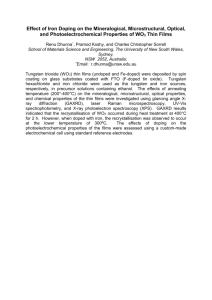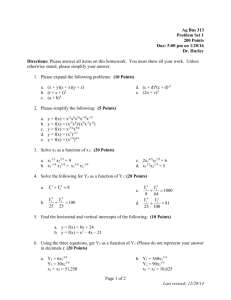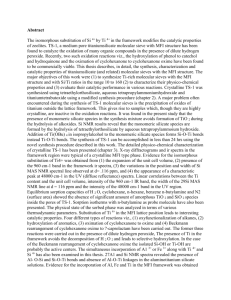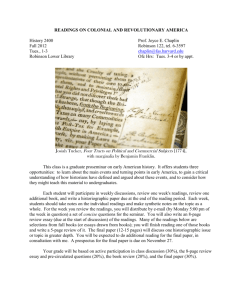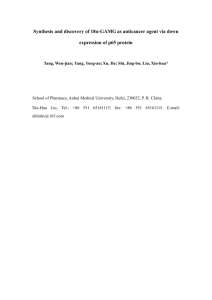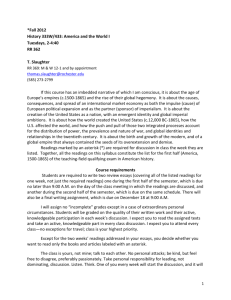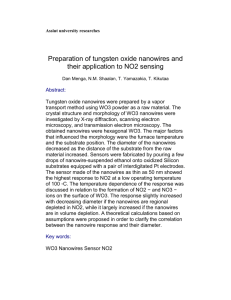tungsten epoxide
advertisement
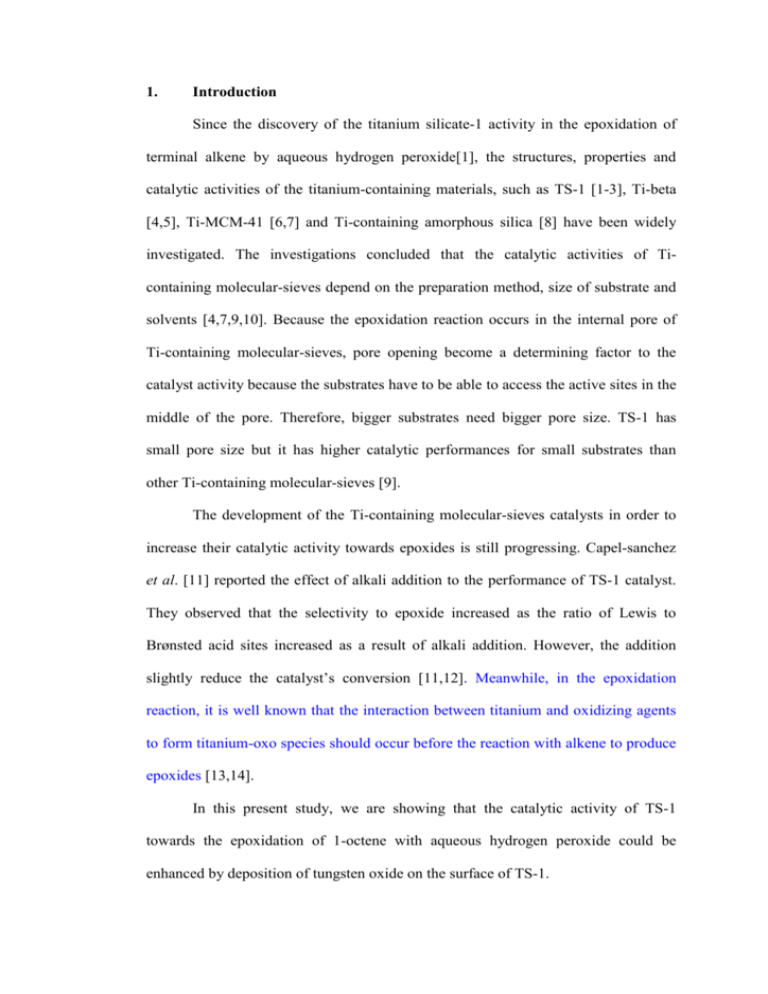
1. Introduction Since the discovery of the titanium silicate-1 activity in the epoxidation of terminal alkene by aqueous hydrogen peroxide[1], the structures, properties and catalytic activities of the titanium-containing materials, such as TS-1 [1-3], Ti-beta [4,5], Ti-MCM-41 [6,7] and Ti-containing amorphous silica [8] have been widely investigated. The investigations concluded that the catalytic activities of Ticontaining molecular-sieves depend on the preparation method, size of substrate and solvents [4,7,9,10]. Because the epoxidation reaction occurs in the internal pore of Ti-containing molecular-sieves, pore opening become a determining factor to the catalyst activity because the substrates have to be able to access the active sites in the middle of the pore. Therefore, bigger substrates need bigger pore size. TS-1 has small pore size but it has higher catalytic performances for small substrates than other Ti-containing molecular-sieves [9]. The development of the Ti-containing molecular-sieves catalysts in order to increase their catalytic activity towards epoxides is still progressing. Capel-sanchez et al. [11] reported the effect of alkali addition to the performance of TS-1 catalyst. They observed that the selectivity to epoxide increased as the ratio of Lewis to Brønsted acid sites increased as a result of alkali addition. However, the addition slightly reduce the catalyst’s conversion [11,12]. Meanwhile, in the epoxidation reaction, it is well known that the interaction between titanium and oxidizing agents to form titanium-oxo species should occur before the reaction with alkene to produce epoxides [13,14]. In this present study, we are showing that the catalytic activity of TS-1 towards the epoxidation of 1-octene with aqueous hydrogen peroxide could be enhanced by deposition of tungsten oxide on the surface of TS-1. 2. Experimental 2.1. Preparation of materials Titanium silicalite (TS-1, 3% of titanium, mol%) was prepared according to a procedure described earlier [1]. The WOx/TS-1 catalysts were prepared by impregnation technique using an aqueous solution containing sufficient amount of ammonium metatungstate hydrate (NH4)6 H2W12O41. 18H2O, to produce materials with WO3 loading in the ranges of 2 – 25 wt%. The suspension was heated at 110oC for 3 h under stirring condition, followed by drying at 110oC for 24 h and calcination at 550oC for 6 h. The samples were denoted by their weight percentage of WO 3 on TS-1. Table 1 shows the amount of WO3 loading and preparation condition. 2.2. Characterization The catalyst structure was characterized by XRD and infrared spectroscopy techniques. The catalyst samples were characterized by powder X-ray diffraction (XRD) for the crystallinity and phase content of the solid materials using a Bruker Advance D8 Difractometer with Cu K (=1.5405 Å) radiation as the diffracted monochromatic beam at 40 kV and 40 mA. The pattern was scanned in the 2 ranges from 5o to 50o at a step size 0.010o and step time 1s. The acidity of samples was determined by infrared spectroscopy technique using pyridine as a probe molecule. The wafer of the sample (10-12 mg) was locked in the cell equipped with CaF2 windows, and evacuated at 400oC under vacuum for 4 h. After evacuation, the cell was allowed to cooling down to room temperature then the pyridin adsorption process was carried out. Excess pyridin was evacuated at 150oC for 1 h. Then, the infrared spectra of the sample were recorded at room temperature in the region of 1400 - 1700 cm-1 using Shimadzu Fourier Transform Infrared (FTIR). 2.3. Catalytic activity The catalyst performance was tested in the epoxidation of 1-octene using aqueous H2O2 (30%) as an oxidant. The reaction mixture containing 1-octene (8 mmol), H2O2 (8 mmol) and acetone (10 g) as solvent was placed in a round bottom flask equipped with a condenser. The catalyst (0.05 g TS-1 based) was then added to the mixture. The reaction was carried out in an oil bath under stirring at 70oC (for how many hours/minutes?). The products of the reaction were analyzed by a Hewlett-Packard 6890N gas chromatograph using an Ultra-1 column (for what molecules) and a Hewlett-Packard GC-MSD instrument using an HP5 column (for what molecules?). 3. Results and discussion 3.1. Structural characterization of WO3/TS-1 materials The XRD patterns of the TS-1 and WO3/TS-1 samples with various tungsten loading and condition are shown in Fig. 1. Generally, the MFI structure of TS-1 was still retained after dispersion of WO3 on the surface of TS-1. The peak intensities of the crystalline WO3 in the WO3/TS-1 samples increase as the amount of WO3 loading increase due to the higher concentration of WO3 on the surface of the TS-1 support. The peaks corresponding to the crystalline phase of WO3 appear at 2 = 23.1, 23.7, 24.4, 33.2-34.6, and 41.5o, in which the peaks at 2 = 23-25o overlapping with the peaks of TS-1, is only observed for the WO3/TS-1 samples with high amount of tungsten loading, ca. 10, 15 and 25 wt%. The crystalline phase of WO3 were not observed for the WO3/TS-1 samples with low loading amount of WO3, ca. 2, 5 and 7 wt%. The result demonstrates that crystalline WO3 appears only in samples with high loading while the WO3 exists as highly dispersed species in the low loading samples. Wang et al. [15] reported that the characteristic peaks of crystalline WO3 were clearly seen for the samples with high loading amount of WO3, ca. >6% and 10%, depending on the nature of silica support. The peak intensities of the crystalline WO3 in the WO3/TS-1 samples increase with the increase of WO3 loading, due to the increase of the WO3 concentration on the surface of the TS-1 support. The surface concentration of metal dispersed in the support can be calculated quantitatively based on the amount of metal oxide loading [15]. Based on the graph of the surface concentration of the tungsten versus the ratio of the diffraction peak intensity of WO3 to that of TS-1 (IWO3/ITS-1; 2: 34.17o/23.04o) in various WO3 loading, the dispersion capacity of tungsten on the titanium silicalite support was evaluated to be 0.35 W6+ cations/nm2, by extrapolating the straight line to get the intercept on the abscissa (not shown). The acidity of tungsten oxide loaded TS-1 samples was investigated by infrared spectroscopy using pyridine as the probe molecule. Fig. 2 shows the infrared spectra of the samples at various tungsten loadings after evacuation at 150oC under vacuum for an hour. Sample TS-1 shows peaks at around 1606, 1490, and 1447 cm-1. The peak at around 1606 and 1447 cm-1 are assigned to Lewis acid sites, suggesting that TS-1 possesses only Lewis acid. Meanwhile, all WO3/TS-1 samples show peaks at around 1637, 1606, 1544, 1490, and 1447 cm-1. The small peak at around 1544 cm-1 and the strong peak at around 1446 cm-1 indicate that all the samples contain both Brønsted and Lewis acid sites. The calculated amount of both Brønsted and Lewis acid sites in the samples are tabulated in Table 1. It was found that Brønsted acid sites were formed in the TS1 upon introduction of tungsten oxide even at low tungsten loading, such as in 2WO3/TS-1. However, as the amount of tungsten loading increased, there was no significant increase in the Brønsted acid sites and even at very high tungsten loading (25 wt%) the amount of Brønsted acid sites seems to decrease slightly. This finding indicates that the creation of Brønsted acid in the TS-1 occurs only at low tungsten oxide loading. Further addition of tungsten oxide (at the higher loading amount) does not create any of Brønsted acid sites. It is further suggested that the formation of Brønsted acid sites is due to the reaction of tungsten with the surface silanol groups on the TS-1 to form the new bonding i.e. Si-O-W. Therefore, once all silanol reacted with tungsten, the additional tungsten will not form any more Brønsted acid sites. The excess tungsten creates tungsten oxide as bulk oxide, as can be observed in the infrared spectra of the framework vibration (not shown). Consequently, amount of atomic interaction of W-O-Si bond is lower as compare to W-O-W bond. For Lewis acid, addition of tungsten on TS-1 at low and high loadings does not significantly change the amount of Lewis acid sites. It suggests that tungsten oxide supported on TS-1 does not increase Lewis acid sites significantly, although according to Meijers et al. [16], tungsten oxide itself possesses Lewis acid sites. Meanwhile, Lucas et al. [17] have reported that the HZSM-5 acidity decreased after impregnation by tungsten. Table 1 also shows the area of the peak at around 1490 cm-1 that can be assigned to total amount of acid sites (Brønsted and Lewis). The table shows that the area increases as WO3 loading increases up to 7 wt%. Wang et al. [15] reported that the height of ammonia desorption peak increased with the increased of WO3 loading up to 6 wt%. Therefore, for total amount of acid sites, it is found to increase up to monolayer coverage. In this study, it is suggested that the coordinately bonding of tungsten species with hydroxyl groups on the surface of TS-1 can be correlated with Brønsted acid sites. Martin et al. [18] reported the formations of Brønsted acid sites in the tungsten oxide supported silica. The formation of Brønsted acid sites in the supported tungsten oxide on the various supports such as alumina, titania, zirconia, silica and mixed oxides have also been reported [19-21]. 3.2. Catalytic activity The activity of the TS-1 and WO3/TS-1 catalysts were tested in the epoxidation of 1-octene using H2O2 as the oxidant at 70oC for 3 h. The main products of the reaction were 1,2-epoxyoctane and 1,2-octanediol. Fig. 3 shows the graph of the rate of formation of 1,2-epoxyoctane vs. reaction time. All samples show activity towards the epoxidation of 1-octene. Compare to WO3/TS-1 catalysts, sample TS-1 shows the lowest rate of the formation of 1,2-epoxyoctane. Therefore, the high rate of 1,2-epoxyoctane formation observed in the reaction mixture catalyzed by samples WO3/TS-1 may be due to the presence of WO3 in the catalysts. However, the yield of 1,2-epoxyoctane decreased as WO3 loading increased in all reaction time. Since among the catalysts used in the reaction have the similar amount of TS-1, this finding suggest that in this condition, the WO3 is not active in the epoxidation of 1-octene. Furthermore, for the activity of WO3/TS-1 catalysts, it can be seen in Fig. 3 that the rate of 1,2-epoxyoctane formation increased very rapidly at the initial stage, and then further increased gradually with the reaction time up to 3 h. The high rate of the formation of 1,2-epoxyoctane observed in the initial stage of reaction time on WO3/TS-1 catalysts can be explained in term of the hydrophilicity of the catalysts. Generally, in the catalytic reaction by heterogeneous catalysts, the first step of the reaction involve adsorption of the substrate on the surface of the catalysts to form intermediate, followed by reaction in the catalyst, and finally desorption of the product from the catalyst. In this reaction, the 1-octene is a non-polar molecule, while H2O2 is a polar molecule. Therefore, 1-octene will be adsorbed immediately at the catalyst with high hydrophobicity. Sample TS-1 has higher hydrophobic properties than WO3/TS-1. Consequently, when catalyst TS-1 is added into the solution of 1-octene and H2O2, the adsorption of 1-octene on the TS-1 is faster than that of H2O2. Meanwhile, it is known that in the epoxidation of alkene, the active sites is oxo-titanium complex which is formed by interaction of titanium species with hydrogen peroxide [13,14]. Therefore, it is expected that the faster interaction of H2O2 with titanium in the TS-1 result the faster formation of oxotitanium species. As a results, the formation of 1,2-epoxyoctane was found to increased. Therefore, based on these finding, it is concluded that the high rate of the formation of 1,2-epoxyoctane observed on the samples WO3/TS-1 may due to the higher hydrophilicity of these catalysts than TS-1. Fig. 4 shows the dependence of the TOF (mol oxide/mol titanium/h) on the amount of WO3 loading in WO3/TS-1 for the epoxidation of 1-octene with aqueous H2O2 at 70oC for 1 h. All WO3/TS-1 catalysts showed higher TOF than the parent TS-1. Among the WO3/TS-1 catalysts, it is found that the TOF decreased sharply with an increasing amount of WO3 loading. This finding suggests that the capability of substrate to access the oxo-titanium active sites inside the pore of TS-1 is easier at lower amount of WO3 loading. The pore opening of TS-1 is blocked by tungsten oxide at the high amount of WO3 loading. This explanation is supported by the finding that the rate of formation of 1,2-epoxyoctane after one hour of reaction time decreased on sample 7WO3/TS-1 (Fig. 3). Based on the XRD data (the graph is not shown), it was found that the dispersion capacity of tungsten on the titanium silicalite is 0.35 W6+/nm2, which close to the 7 wt% of WO3 on TS-1. Meanwhile, the higher activity observed in the sample with lower WO3 loading indicated that only small amount of WO3 is needed to increase the hydrophilicity of TS-1 for the formation of oxo-titanium species. The yields of 1,2-octanediol versus reaction time using various catalysts are depicted in Fig. 5. It is found that the yield of 1,2-octanediol increased as the amount of WO3 loading increased. The highest yield of 1,2-octanediol was observed on the sample 25WO3/TS-1 at every reaction time. It is known that the formation of 1,2octanediol from 1,2-epoxyoctane is catalyzed by both Brønsted and Lewis acid sites. In this study, it is found that the yield of 1,2-octanediol increased as the amount of Brønsted and Lewis acid sites increased. Therefore, catalysts with high amount of Brønsted and Lewis acid sites showed high yields of 1,2-octanediol. However, when the yield of 1,2-octanediol is divided by the amount of Brønsted acid sites, it is observed that its ratio increased as the increased of tungsten loading up to 7 wt% (value of monolayer coverage). Therefore, it can be explained that the effective Brønsted acid sites are located in immediate vicinity of the titanium sites (oxidative sites) that was generated by the interaction of W-O-Si in the surface of TS-1. The increased of 1,2-octanediol observed in high loading of WO3 due to the higher amount of Lewis acid sites presence in the catalysts. In WO3/TS-1 catalysts, it shows that the turn over frequency, TOF, increased as the WO3 loading increased up to sample 7WO3/TS-1, and then decreased in samples with higher WO3 loading (Table 1). Hence, it is concluded that the highest catalytic activity can be observed in the catalysts with monolayer coverage containing the highest W-O-Si bond. Meanwhile, for selectivity of 1,2-octanediol, it is found that the highest selectivity was observed in sample 25WO3/TS-1 due to high amount of Brønsted and Lewis acid sites involved during the reaction. 4. Conclusions Impregnation of tungsten oxides (WO3) onto titanium silicalite (TS-1) was studied. The XRD data showed that after incorporation of tungsten oxide, the MFI structure of TS-1 still remained although with lower crystallinity. In the epoxidation of 1-octene with aqueous H2O2 in acetone as a solvent, the WO3/TS-1 catalysts showed higher activity than the initial TS-1 due to higher hydrophylicity of the WO3/TS-1 catalysts. Brønsted acid sites have been generated in the WO3/TS-1 catalysts. It was found that all WO3/TS-1 catalysts with different amounts of tungsten loading contain similar amount of Brønsted acid sites. Consequently, the activities of the catalysts for the formation of 1,2-octanediol from 1-octene were found to be similar. It was suggested that the Brønsted acid sites were formed due to formation of Si-O-W bond in the WO3/TS-1 catalysts. Acknowledgement We gratefully acknowledge funding from The Ministry of Science Technology and Innovation Malaysia (MOSTI), under IRPA grant no. 09-02-060057 SR0005/09-03. References [1] M. Taramasso, G. Perego and B. Notari, (1983) U. S. Patents No. 4,410,501. [2] M.G. Clerici and P. Ingallina, (1993) US Patent No. 5,221,795. [3] M.G. Clerici and P. Ingallina, Catal. Today 41 (1998) 351. [4] J.C. van der Waal, M.S. Rigutto and H. van Bekkum, Appl. Catal. A: General 167 (1998) 331. [5] S. Krijnen, P. Sánchez, B.T.F. Jakobs and J.H.C. van Hooff, Microporous and Mesoporous Mater. 31 (1999) 163. [6] T. Blasco, A. Corma, M.T. Navarro and J.P. Pariente, J. Catal. 156 (1995) 65. [7] K.T. Li and C.C. Lin, Catal. Today, 97(2004) 257. [8] H. Kochkar and F. Figueras, J. Catal. 171 (1997) 420. [9] C. Perego, A. Carati, P. Ingallina, M.A. Mantegazza and G. Bellussi, Appl. Catal. A: General 221 (2001) 63. [10] M.C. Capel-Sanchez, J.M. Campos-Martin and J.L.G. Fierro, J. Catal., 234 (2005) 488. [11] M.C. Capel-Sanchez, J.M. Campos-Martin and J.L.G. Fierro, Appl. Catal. A: General 246 (2003) 69. [12] T. Tatsumi, K.A. Koyano and Y. Shimizu, Appl. Catal. A: General, 200 (2000) 125. [13] D. Srinivas, P. Manikandan, S.C. Laha, R. Kumar and P. Ratnasamy, J. Catal. 217 (2003) 160. [14] F. Bonino, A. Damin, G. Ricchiardi, M. Ricci, G. Spano, R. D'Aloisio, A. Zecchina, C. Lamberti, C. Prestipino and S. Bordiga, J. Phys. Chem. B. 108 (2004) 3573. [15] Y. Wang, Q. Chen, W. Yang, Z. Xie, W. Xu and D. Huang, Appl. Catal. A: General 250 (2003) 25. [16] S. Meijers, L. Gielgens and V. Ponec, J. Catal. 156 (1995) 147. [17] A. Lucas, J.L. Valverde, L. Rodriguez, P. Sanchez and M.T. Garcia, Appl. Catal. A: General 171 (2001) 195. [18] C. Martin, P. Malet, G. Solana and V. Rives, J. Phys. Chem. B. 102 (1998) 2759. [19] A. Gutiérrez-Alejandre, P. Castillo, J. Ramýrez, G. Ramis and G. Busca, Appl. Catal. A: General 216 (2001) 181. [20] J. Macht, C.D. Baertsch, M. May-Lozano, S.L. Soled, Y. Wang and E. Iglesia, J. Catal. 227 (2004) 479. [21] A.S. Mamede, E. Payen, P. Grange, G. Poncelet, A. Ion, M. Alifanti and V.I. Pârvulescu, J. Catal. 223 (2004) 1.
